Recent Patterns and Trends of Snow Cover (2000–2023) in the Cantabrian Mountains (Spain) from Satellite Imagery Using Google Earth Engine
Abstract
:1. Introduction
2. Materials and Methods
2.1. Creation of Daily Snow Cover Image Collection
2.2. Data Gap-Filling Due to Cloud Cover
- If an image D − i has snow, D has no data (cloud), and D + i has snow → D is classified as snow.
- If an image D − i is snow-free, D has no data (cloud), and D + i is snow-free → D is classified as snow-free.
- If an image D − i is snow-free, D has no data (cloud), and D + i has snow → D is classified as snow. D is classified as snow from the day when the simple interpolation of NDSI or FSC values from the last available data to the first available data after the gap indicates snow presence.
- If an image D − i is snow-covered, D has no data (cloud), and D + i is snow-free → D is classified as snow. D is classified as snow from the day when the simple interpolation of NDSI or FSC values from the last available data to the first available data after the gap indicates snow presence.
2.3. Extraction of Snow-Cover Days (SCDs) and Snow-Cover Fraction (SCF) Statistics
- Snow-Cover Days (SCDs): for each pixel, the calculation of the number of images where the pixel is snow-covered divided by the total number of valid (cloud-free) images, multiplied by 365. Calculations are made for the period from October 2000 to September 2023 and values can range between 0 and 365 days of snow cover.
- Annual Snow-Cover Days (aSCDs): for each season (October—September), the same calculation as SCDs. This statistic is used to calculate trends. Values can range between 0 and 365 days.
- Trends in Snow-Cover Days: Sen’s slope test [69] is applied to annual SCDs to assess the magnitude and direction of the trend over time in a yearly scale. Additionally, the Mann–Kendall test [70,71] is employed at a 95% confidence level to determine the significance of these trends. Absolute and relative trend is calculated. The absolute trend refers to the number of days per year that the SCDs changes (a −0.5 value means it decreases by 0.5 days each year, or 5 days every 10 years). In contrast, the relative trend is calculated considering the average SCDs for each pixel, resulting in a percentage value (a −0.5 value of relative trend means that the snow cover decreases by 0.5% from the average snow cover value at that point each year, or by 5% every 10 years).
- Snow-Cover Fraction (SCF): for the entire Cantabrian Mountains, the daily calculation of the number of snow-covered pixels/total number of available pixels (cloud-free) in the area. Values can vary daily between 0 and 1, being zero when no area of the valid (cloud-free) pixels are covered by snow and one when, on a specific day, all valid (cloud-free) pixels are snow-covered. Satellite values will be compared with the SCF records of the ‘snow_cover’ variable data from the ERA5-Land climate reanalysis product [72], although it is important to note that it is a product with a resolution of 0.1° (11,132 m).
- Altitudinal Snow-Cover Fraction: the same calculation as SCF for 500 m altitudinal bands of the Cantabrian Mountains: SCF < 500 m; SCF 500–1000 m: SCF 1000–1500 m; SCF 1500–2000 m; SCF > 2000 m. The chosen model is the 1st coverage Digital Terrain Model (2009–2015) with a 25 m grid spacing (MDT25) from Spain’s National Cartographic System. It was created from LiDAR point clouds of the PNOA-LiDAR project (2009–2015), has a resolution of 25 m, and a vertical resolution of 0.001 m (https://www.idee.es/csw-inspire-idee/srv/spa/catalog.search?#/metadata/spaignMDT25, accessed on 31 July 2024).
- Percentile of the average monthly SCF value. For each month of each year, the average SCF is calculated and compared to the monthly value for each season, once the data are ordered from lowest to highest. The percentile indicates the position of a value within a dataset, showing the value below which a given percentage of observations are found. For example, the 50th percentile represents the median value, where half of the observations are below and half are above. Values close to the 0th percentile are exceptionally low for that month, while values close to the 100th percentile are exceptionally high compared to the records for that month during the period 2000–2023. It has only been carried out for the months from October to June, because in July, August and September the snow cover is practically non-existent.
3. Results
3.1. Snow-Cover Days (SCDs)
3.2. Trends in Snow-Cover Days (SCDs)
3.3. Daily Extent of Snow Cover at Mountain Range Level: The Snow-Cover Fraction (SCF)
4. Discussion
4.1. Advantages and Limitations in the Detection of Snow Cover Using Satellite Imagery in Google Earth Engine
4.2. Comparison of SCD Values Obtained in Other Studies
4.3. Trends in Snow-Cover Duration in Nearby Mountain Ranges
4.4. Seasonal Regime of SCF in the Cantabrian Mountains: Comparison with Nearby Areas and Climate Reanalysis Products
5. Conclusions
- Monitoring snow cover through satellite images enables continuous tracking of snow conditions, regardless of the availability of ground-based observations. Google Earth Engine has facilitated the processing of 10,831 satellite images from Sentinel-2, Landsat 5, Landsat 8, and Terra-MODIS to identify snow cover.
- Detecting snow cover presents challenges in areas such as steep slopes and forested regions and during prolonged cloud cover, often leading to underestimation of snow cover in these zones. Cloud cover (which ranged from 41.7% to 69.1%) was masked out in the analysis. Integrating multiple satellite data sources reduces data gaps and improves coverage. The hierarchical pixel method using data from three satellites achieves optimal spatial resolution when feasible. Additionally, temporal gap-filling techniques address data absences caused by cloud cover, which could last up to 5 days. The combination of Sentinel and Landsat data, despite their limited swath width, with MODIS pixels provides comprehensive coverage of the entire study area.
- The Cantabrian Mountains exhibit a very irregular distribution of snow-cover days, highly influenced by altitude and local topography. The average duration of snow cover in the Cantabrian Mountains is 30.1 days, with significant differences across altitudinal zones, ranging from 5.7 days below 500 m to an average of 131.6 days above 2000 m, with durations exceeding 300 days in reduced elevated areas, where snow accumulation and topography favour its persistence for nearly the entire year.
- Decreasing trends in the duration of snow cover have been observed in most parts of the Cantabrian Mountains, more intensely on the southern slope, with hardly any longitudinal gradient. The overall trend in duration for the period 2000–2023 is −0.26 days/year, with the most significant decrease observed in the 1500–2000 m range (−0.78 days/year), implying annual losses of around 1–1.5%. In areas with significant trends, mainly located in the southwestern and southeastern massifs of the Cantabrian Mountains, the decline is pronounced, at −0.9 days/year and −1.3 days/year in areas above 1500 m, representing an annual decrease of around 1.5–3.1% in areas with significant trend.
- The analysis of SCF has revealed differences in the duration of snow cover, which has an irregular pattern throughout the season. Differences across altitudinal zones were analysed on a seasonal scale, observing more stable snow cover patterns at higher altitudinal zones (>2000 m), but with significant interannual variations in all altitudinal ranges.
- The aggregation of SCF by percentiles on a monthly scale has allowed the detection of seasons with greater snow cover (such as 2008–2009) compared to seasons with anomalously low snow cover (2016–2017), as well as identifying specific months where snow cover is exceptionally high (such as February 2015, ranked in the 94th percentile of conditions recorded in February) or low (such as October or December 2018, with a percentile below 10).
- The methodology employed in this article using satellite images is a very useful tool, especially for areas with sparse snow observation networks. This methodology, which has enabled the extraction of a daily time series of snow cover for the Cantabrian Mountains, could be analysed on a more local scale in future works, or even supported by other forms of on-ground snow observation, such as webcam images.
Supplementary Materials
Funding
Data Availability Statement
Acknowledgments
Conflicts of Interest
References
- Qin, Y.; Abatzoglou, J.T.; Siebert, S.; Huning, L.S.; AghaKouchak, A.; Mankin, J.S.; Hong, C.; Tong, D.; Davis, S.J.; Mueller, N.D. Agricultural Risks from Changing Snowmelt. Nat. Clim. Chang. 2020, 10, 459–465. [Google Scholar] [CrossRef]
- Mankin, J.S.; Viviroli, D.; Singh, D.; Hoekstra, A.Y.; Diffenbaugh, N.S. The Potential for Snow to Supply Human Water Demand in the Present and Future. Environ. Res. Lett. 2015, 10, 114016. [Google Scholar] [CrossRef]
- García-Ruiz, J.M.; Arnáez, J.; Lasanta, T.; Nadal-Romero, E.; López-Moreno, J.I. Snow in the Mountains. In Mountain Environments: Changes and Impacts. Natural Landscapes and Human Adaptations to Diversity; Negm, A.M., Chaplina, T., Eds.; Springer: Cham, Switzerland, 2024; pp. 117–137. [Google Scholar] [CrossRef]
- Vajda, A.; Tuomenvirta, H.; Juga, I.; Nurmi, P.; Jokinen, P.; Rauhala, J. Severe Weather Affecting European Transport Systems: The Identification, Classification and Frequencies of Events. Nat. Hazards 2014, 72, 169–188. [Google Scholar] [CrossRef]
- Haeberli, W.; Whiteman, C. Snow and Ice-Related Hazards, Risks, and Disasters: A General Framework. In Snow Ice-Relat. Hazards Risks Disasters; Shroder, J.F., Haeberli, W., Whiteman, C., Eds.; Elsevier: Amsterdam, The Netherlands, 2015; pp. 1–34. [Google Scholar] [CrossRef]
- Schweizer, J.; Jamieson, J.B.; Schneebeli, M. Snow Avalanche Formation. Rev. Geophys. 2003, 41, 1016. [Google Scholar] [CrossRef]
- Eckerstorfer, M.; Bühler, Y.; Frauenfelder, R.; Malnes, E. Remote Sensing of Snow Avalanches: Recent Advances, Potential, and Limitations. Cold Reg. Sci. Technol. 2016, 121, 126–140. [Google Scholar] [CrossRef]
- Fayad, A.; Gascoin, S.; Faour, G.; López-Moreno, J.I.; Drapeau, L.; Le Page, M.; Escadafal, R. Snow Hydrology in Mediterranean Mountain Regions: A Review. J. Hydrol. 2017, 551, 374–396. [Google Scholar] [CrossRef]
- Tramblay, Y.; Koutroulis, A.; Samaniego, L.; Vicente-Serrano, S.M.; Volaire, F.; Boone, A.; Le Page, M.; Llasat, M.C.; Albergel, C.; Burak, S.; et al. Challenges for Drought Assessment in the Mediterranean Region under Future Climate Scenarios. Earth Sci. Rev. 2020, 210, 103348. [Google Scholar] [CrossRef]
- Beniston, M.; Stoffel, M. Rain-on-Snow Events, Floods and Climate Change in the Alps: Events May Increase with Warming up to 4 °C and Decrease Thereafter. Sci. Total Environ. 2016, 571, 228–236. [Google Scholar] [CrossRef]
- Morán-Tejeda, E.; López-Moreno, J.I.; Stoffel, M.; Beniston, M. Rain-on-Snow Events in Switzerland: Recent Observations and Projections for the 21st Century. Clim. Res. 2016, 71, 111–125. [Google Scholar] [CrossRef]
- Morán-Tejeda, E.; Fassnacht, S.R.; Lorenzo-Lacruz, J.; López-Moreno, J.I.; García, C.; Alonso-González, E.; Collados-Lara, A.J. Hydro-Meteorological Characterization of Major Floods in Spanish Mountain Rivers. Water 2019, 11, 2641. [Google Scholar] [CrossRef]
- Corripio, J.G.; López-Moreno, J.I. Analysis and Predictability of the Hydrological Response of Mountain Catchments to Heavy Rain on Snow Events: A Case Study in the Spanish Pyrenees. Hydrology 2017, 4, 20. [Google Scholar] [CrossRef]
- Di Mauro, B.; Fava, F.; Ferrero, L.; Garzonio, R.; Baccolo, G.; Delmonte, B.; Colombo, R. Mineral Dust Impact on Snow Radiative Properties in the European Alps Combining Ground, UAV, and Satellite Observations. J. Geophys. Res. Atmos. 2015, 120, 6080–6097. [Google Scholar] [CrossRef]
- Réveillet, M.; Dumont, M.; Gascoin, S.; Lafaysse, M.; Nabat, P.; Ribes, A.; Nheili, R.; Tuzet, F.; Ménégoz, M.; Morin, S.; et al. Black Carbon and Dust Alter the Response of Mountain Snow Cover under Climate Change. Nat. Commun. 2022, 13, 5279. [Google Scholar] [CrossRef]
- Dumont, M.; Tuzet, F.; Gascoin, S.; Picard, G.; Kutuzov, S.; Lafaysse, M.; Cluzet, B.; Nheili, R.; Painter, T.H. Accelerated Snow Melt in the Russian Caucasus Mountains after the Saharan Dust Outbreak in March 2018. J. Geophys. Res. Earth Surf. 2020, 125, e2020JF005641. [Google Scholar] [CrossRef]
- García-Ruiz, J.M.; López-Moreno, I.I.; Vicente-Serrano, S.M.; Lasanta-Martínez, T.; Beguería, S. Mediterranean Water Resources in a Global Change Scenario. Earth Sci. Rev. 2011, 105, 121–139. [Google Scholar] [CrossRef]
- Morán-Tejeda, E.; Ceballos-Barbancho, A.; Llorente-Pinto, J.M. Hydrological Response of Mediterranean Headwaters to Climate Oscillations and Land-Cover Changes: The Mountains of Duero River Basin (Central Spain). Glob. Planet. Chang. 2010, 72, 39–49. [Google Scholar] [CrossRef]
- López-Moreno, J.I.; Gascoin, S.; Herrero, J.; Sproles, E.A.; Pons, M.; Alonso-González, E.; Hanich, L.; Boudhar, A.; Musselman, K.N.; Molotch, N.P.; et al. Different Sensitivities of Snowpacks to Warming in Mediterranean Climate Mountain Areas. Environ. Res. Lett. 2017, 12, 074006. [Google Scholar] [CrossRef]
- Sanmiguel-Vallelado, A.; Morán-Tejeda, E.; Alonso-González, E.; López-Moreno, J.I. Effect of Snow on Mountain River Regimes: An Example from the Pyrenees. Front. Earth Sci. 2017, 11, 515–530. [Google Scholar] [CrossRef]
- Thornton, J.M.; Palazzi, E.; Pepin, N.C.; Cristofanelli, P.; Essery, R.; Kotlarski, S.; Giuliani, G.; Guigoz, Y.; Kulonen, A.; Pritchard, D.; et al. Toward a Definition of Essential Mountain Climate Variables. One Earth 2021, 4, 805–827. [Google Scholar] [CrossRef]
- The 2022 GCOS Implementation Plan (GCOS-244). Available online: https://library.wmo.int/records/item/58104-the-2022-gcos-implementation-plan-gcos-244 (accessed on 23 July 2024).
- Schaffhauser, A.; Adams, M.; Fromm, R.; Jörg, P.; Luzi, G.; Noferini, L.; Sailer, R. Remote Sensing Based Retrieval of Snow Cover Properties. Cold Reg. Sci. Technol. 2008, 54, 164–175. [Google Scholar] [CrossRef]
- Nolin, A.W. Recent Advances in Remote Sensing of Seasonal Snow. J. Glaciol. 2010, 56, 1141–1150. [Google Scholar] [CrossRef]
- Dietz, A.J.; Kuenzer, C.; Gessner, U.; Dech, S. Remote Sensing of Snow—A Review of Available Methods. Int. J. Remote Sens. 2012, 33, 4094–4134. [Google Scholar] [CrossRef]
- Matiu, M.; Jacob, A.; Notarnicola, C. Daily MODIS Snow Cover Maps for the European Alps from 2002 Onwards at 250 m Horizontal Resolution along with a Nearly Cloud-Free Version. Data 2019, 5, 1. [Google Scholar] [CrossRef]
- Dedieu, J.P.; Lessard-Fontaine, A.; Ravazzani, G.; Cremonese, E.; Shalpykova, G.; Beniston, M. Shifting Mountain Snow Patterns in a Changing Climate from Remote Sensing Retrieval. Sci. Total Environ. 2014, 493, 1267–1279. [Google Scholar] [CrossRef] [PubMed]
- Salzano, R.; Salvatori, R.; Valt, M.; Giuliani, G.; Chatenoux, B.; Ioppi, L. Automated Classification of Terrestrial Images: The Contribution to the Remote Sensing of Snow Cover. Geosciences 2019, 9, 97. [Google Scholar] [CrossRef]
- Dozier, J. Spectral Signature of Alpine Snow Cover from the Landsat Thematic Mapper. Remote Sens. Environ. 1989, 28, 9–22. [Google Scholar] [CrossRef]
- Hall, D.K.; Riggs, G.A.; Salomonson, V.V. Development of Methods for Mapping Global Snow Cover Using Moderate Resolution Imaging Spectroradiometer Data. Remote Sens. Environ. 1995, 54, 127–140. [Google Scholar] [CrossRef]
- Hall, D.K.; Riggs, G.A. Normalized-Difference Snow Index (NDSI). In Encyclopedia of Earth Sciences Series; Springer: Dordrecht, The Netherlands, 2011; Part 3; pp. 779–780. [Google Scholar] [CrossRef]
- Sudmanns, M.; Tiede, D.; Augustin, H.; Lang, S. Assessing Global Sentinel-2 Coverage Dynamics and Data Availability for Operational Earth Observation (EO) Applications Using the EO-Compass. Int. J. Digit. Earth 2020, 13, 768–784. [Google Scholar] [CrossRef]
- Gascoin, S.; Luojus, K.; Nagler, T.; Lievens, H.; Masiokas, M.; Jonas, T.; Zheng, Z.; De Rosnay, P. Remote Sensing of Mountain Snow from Space: Status and Recommendations. Front. Earth Sci. 2024, 12, 1381323. [Google Scholar] [CrossRef]
- Muhuri, A.; Gascoin, S.; Menzel, L.; Kostadinov, T.S.; Harpold, A.A.; Sanmiguel-Vallelado, A.; Lopez-Moreno, J.I. Performance Assessment of Optical Satellite-Based Operational Snow Cover Monitoring Algorithms in Forested Landscapes. IEEE J. Sel. Top. Appl. Earth Obs. Remote Sens. 2021, 14, 7159–7178. [Google Scholar] [CrossRef]
- Premier, V.; Marin, C.; Bertoldi, G.; Barella, R.; Notarnicola, C.; Bruzzone, L. Exploring the Use of Multi-Source High-Resolution Satellite Data for Snow Water Equivalent Reconstruction over Mountainous Catchments. Cryosphere 2023, 17, 2387–2407. [Google Scholar] [CrossRef]
- Luo, J.; Dong, C.; Lin, K.; Chen, X.; Zhao, L.; Menzel, L. Mapping Snow Cover in Forests Using Optical Remote Sensing, Machine Learning and Time-Lapse Photography. Remote Sens. Environ. 2022, 275, 113017. [Google Scholar] [CrossRef]
- Gorelick, N.; Hancher, M.; Dixon, M.; Ilyushchenko, S.; Thau, D.; Moore, R. Google Earth Engine: Planetary-Scale Geospatial Analysis for Everyone. Remote Sens. Environ. 2017, 202, 18–27. [Google Scholar] [CrossRef]
- Velastegui-Montoya, A.; Montalván-Burbano, N.; Carrión-Mero, P.; Rivera-Torres, H.; Sadeck, L.; Adami, M. Google Earth Engine: A Global Analysis and Future Trends. Remote Sens. 2023, 15, 3675. [Google Scholar] [CrossRef]
- Mutanga, O.; Kumar, L. Google Earth Engine Applications. Remote Sens. 2019, 11, 591. [Google Scholar] [CrossRef]
- Zhao, Q.; Yu, L.; Li, X.; Peng, D.; Zhang, Y.; Gong, P. Progress and Trends in the Application of Google Earth and Google Earth Engine. Remote Sens. 2021, 13, 3778. [Google Scholar] [CrossRef]
- Li, Z.; Liu, C.; Zhang, P.; Tian, B. Assessment of Snow Cover Product Using Google Earth Engine Cloud Computing Platform. Int. Geosci. Remote Sens. Symp. (IGARSS) 2018, 2018, 5203–5205. [Google Scholar] [CrossRef]
- Torabi Poodeh, H.; Yousefi, H.; Samadi, A.; Arshia, A.; Shamsi, Z.; Yarahmadi, Y. Evaluation of Snow Cover Changes Trend Using GEE and TFPW-MK Test (Case Study: Marber Basin-Isfahan). Iran. J. Ecohydrol. 2021, 8, 195–204. [Google Scholar] [CrossRef]
- Abdelkader, M.; Bravo Mendez, J.H.; Temimi, M.; Brown, D.R.N.; Spellman, K.V.; Arp, C.D.; Bondurant, A.; Kohl, H. A Google Earth Engine Platform to Integrate Multi-Satellite and Citizen Science Data for the Monitoring of River Ice Dynamics. Remote Sens. 2024, 16, 1368. [Google Scholar] [CrossRef]
- Calizaya, E.; Laqui, W.; Sardón, S.; Calizaya, F.; Cuentas, O.; Cahuana, J.; Mindani, C.; Huacani, W. Snow Cover Temporal Dynamic Using MODIS Product, and Its Relationship with Precipitation and Temperature in the Tropical Andean Glaciers in the Alto Santa Sub-Basin (Peru). Sustainability 2023, 15, 7610. [Google Scholar] [CrossRef]
- Laurin, G.V.; Francini, S.; Penna, D.; Zuecco, G.; Chirici, G.; Berman, E.; Coops, N.C.; Castelli, G.; Bresci, E.; Preti, F.; et al. SnowWarp: An Open Science and Open Data Tool for Daily Monitoring of Snow Dynamics. Environ. Model. Softw. 2022, 156, 105477. [Google Scholar] [CrossRef]
- Gascoin, S.; Monteiro, D.; Morin, S. Reanalysis-Based Contextualization of Real-Time Snow Cover Monitoring from Space. Environ. Res. Lett. 2022, 17, 114044. [Google Scholar] [CrossRef]
- Crumley, R.L.; Palomaki, R.T.; Nolin, A.W.; Sproles, E.A.; Mar, E.J. SnowCloudMetrics: Snow Information for Everyone. Remote Sens. 2020, 12, 3341. [Google Scholar] [CrossRef]
- Sproles, E.A.; Crumley, R.L.; Nolin, A.W.; Mar, E.; Moreno, J.I.L. SnowCloudHydro—A New Framework for Forecasting Streamflow in Snowy, Data-Scarce Regions. Remote Sens. 2018, 10, 1276. [Google Scholar] [CrossRef]
- El jabiri, Y.; Boudhar, A.; Htitiou, A.; Sproles, E.A.; Bousbaa, M.; Bouamri, H.; Chehbouni, A. A Method for Robust Estimation of Snow Seasonality Metrics from Landsat and Sentinel-2 Time Series Data over Atlas Mountains Scale Using Google Earth Engine. Geocarto Int. 2024, 39, 2313001. [Google Scholar] [CrossRef]
- Ortega Villazán, M.T.; Morales Rodríguez, C.G. El Clima de La Cordillera Cantábrica Castellano-Leonesa: Diversidad, Contrastes y Cambios. Investig. Geogr. 2015, 63, 45–67. [Google Scholar] [CrossRef]
- González Trueba, J.J.; Serrano Cañadas, E. Snow in the Picos de Europa: Geomorphological and Environmental Implications. Cuad. De Investig. Geogr. 2010, 36, 61–84. [Google Scholar] [CrossRef]
- García-Hernández, C.; López-Moreno, J.I. Extreme Snowfalls and Atmospheric Circulation Patterns in the Cantabrian Mountains (NW Spain). Cold Reg. Sci. Technol. 2024, 221, 104170. [Google Scholar] [CrossRef]
- Serrano Cañadas, E.; Gómez Lende, M.; Pisabarro Pérez, A.; Serrano Cañadas, E.; Gómez Lende, M.; Pisabarro Pérez, A. Nieve y Riesgo de Aludes En La Montaña Cantábrica: El Alud de Cardaño de Arriba, Alto Carrión (Palencia). Polígonos Rev. De Geogr. 2016, 28, 239–264. [Google Scholar] [CrossRef]
- Beato Bergua, S.; Poblete Piedrabuena, M.Á.; Marino Alfonso, J.L. Snow Avalanches, Land Use Changes, and Atmospheric Warming in Landscape Dynamics of the Atlantic Mid-Mountains (Cantabrian Range, NW Spain). Appl. Geogr. 2019, 107, 38–50. [Google Scholar] [CrossRef]
- Santos González, J.; Redondo Vega, J.M.; Gómez Villar, A.; González Gutiérrez, R.B. Avalanches in the Alto Sil (Western Cantabrian Mountain, Spain). Cuad. De Investig. Geogr. 2010, 36, 7–26. [Google Scholar] [CrossRef]
- Del Valle Granda, E.; Bergua, S.B.; Pérez, C.R.; Arenas, D.H. Snow Avalanches Susceptibility on the Somiedo Road (Asturias) and Its Dissemination through Augmented Reality. Cuad. Geogr. 2024, 63, 297–317. [Google Scholar] [CrossRef]
- García-Hernández, C.; Ruiz-Fernández, J.; Sánchez-Posada, C.; Pereira, S.; Oliva, M.; Vieira, G. Reforestation and Land Use Change as Drivers for a Decrease of Avalanche Damage in Mid-Latitude Mountains (NW Spain). Glob. Planet. Chang. 2017, 153, 35–50. [Google Scholar] [CrossRef]
- Cañedo, D.G.; Ruiz-Fernández, J.; García-Hernández, C. La Nieve En El Macizo de Las Ubiñas (Montañas Cantábricas) y Sus Implicaciones Geomorfológicas. Boletín De La Asoc. De Geógr. Españoles 2022, 93, 4. [Google Scholar] [CrossRef]
- Merino, A.; Fernández, S.; Hermida, L.; López, L.; Sánchez, J.L.; García-Ortega, E.; Gascón, E. Snowfall in the Northwest Iberian Peninsula: Synoptic Circulation Patterns and Their Influence on Snow Day Trends. Sci. World J. 2014, 2014, 480275. [Google Scholar] [CrossRef] [PubMed]
- Pisabarro, A.; Pisabarro, A. Snow Cover as a Morphogenic Agent Determining Ground Climate, Landforms and Runoff in the Valdecebollas Massif, Cantabrian Mountains. Cuad. De Investig. Geogr. 2020, 46, 81–102. [Google Scholar] [CrossRef]
- Pisabarro, A.; Pellitero, R.; Serrano, E.; Gómez-Lende, M.; González-Trueba, J.J. Ground Temperatures, Landforms and Processes in an Atlantic Mountain. Cantabrian Mountains (Northern Spain). CATENA 2017, 149, 623–636. [Google Scholar] [CrossRef]
- Ruiz-Fernández, J.; García-Hernández, C.; Ochoa-Álvarez, M.; Van den Bergh, M.; Gallinar Cañedo, D.; González-Díaz, B. Ground and Near-Rock Surface Air Thermal Regimes in the High Mountain of the Picos de Europa (Cantabrian Mountains, NW Spain). Air Soil. Water Res. 2023, 16, 11786221231176676. [Google Scholar] [CrossRef]
- Alonso-González, E.; Gutmann, E.; Aalstad, K.; Fayad, A.; Bouchet, M.; Gascoin, S. Snowpack Dynamics in the Lebanese Mountains from Quasi-Dynamically Downscaled ERA5 Reanalysis Updated by Assimilating Remotely Sensed Fractional Snow-Covered Area. Hydrol. Earth Syst. Sci. 2021, 25, 4455–4471. [Google Scholar] [CrossRef]
- Bousbaa, M.; Htitiou, A.; Boudhar, A.; Eljabiri, Y.; Elyoussfi, H.; Bouamri, H.; Ouatiki, H.; Chehbouni, A. High-Resolution Monitoring of the Snow Cover on the Moroccan Atlas through the Spatio-Temporal Fusion of Landsat and Sentinel-2 Images. Remote Sens. 2022, 14, 5814. [Google Scholar] [CrossRef]
- Tuel, A.; El Moçayd, N.; Hasnaoui, M.D.; Eltahir, E.A.B. Future Projections of High Atlas Snowpack and Runoff under Climate Change. Hydrol. Earth Syst. Sci. 2022, 26, 571–588. [Google Scholar] [CrossRef]
- Salomonson, V.V.; Appel, I. Estimating Fractional Snow Cover from MODIS Using the Normalized Difference Snow Index. Remote Sens. Environ. 2004, 89, 351–360. [Google Scholar] [CrossRef]
- Rittger, K.; Painter, T.H.; Dozier, J. Assessment of Methods for Mapping Snow Cover from MODIS. Adv. Water Resour. 2013, 51, 367–380. [Google Scholar] [CrossRef]
- Revuelto, J.; Alonso-González, E.; Gascoin, S.; Rodríguez-López, G.; López-Moreno, J.I. Spatial Downscaling of MODIS Snow Cover Observations Using Sentinel-2 Snow Products. Remote Sens. 2021, 13, 4513. [Google Scholar] [CrossRef]
- Sen, P.K. Estimates of the Regression Coefficient Based on Kendall’s Tau. J. Am. Stat. Assoc. 1968, 63, 1379–1389. [Google Scholar] [CrossRef]
- Mann, H.B. Nonparametric Tests Against Trend. Econometrica 1945, 13, 245. [Google Scholar] [CrossRef]
- Kendall, M.G. Rank Correlation Methods, 4th ed.; Griffin: London, UK, 1975. [Google Scholar]
- Muñoz-Sabater, J.; Dutra, E.; Agustí-Panareda, A.; Albergel, C.; Arduini, G.; Balsamo, G.; Boussetta, S.; Choulga, M.; Harrigan, S.; Hersbach, H.; et al. ERA5-Land: A State-of-the-Art Global Reanalysis Dataset for Land Applications. Earth Syst. Sci. Data 2021, 13, 4349–4383. [Google Scholar] [CrossRef]
- Berman, E.E.; Bolton, D.K.; Coops, N.C.; Mityok, Z.K.; Stenhouse, G.B.; Moore, R.D. (Dan) Daily Estimates of Landsat Fractional Snow Cover Driven by MODIS and Dynamic Time-Warping. Remote Sens. Environ. 2018, 216, 635–646. [Google Scholar] [CrossRef]
- Snapir, B.; Momblanch, A.; Jain, S.K.; Waine, T.W.; Holman, I.P. A Method for Monthly Mapping of Wet and Dry Snow Using Sentinel-1 and MODIS: Application to a Himalayan River Basin. Int. J. Appl. Earth Obs. Geoinf. 2019, 74, 222–230. [Google Scholar] [CrossRef]
- Koskinen, J.; Metsämäki, S.; Grandell, J.; Jänne, S.; Matikainen, L.; Hallikainen, M. Snow Monitoring Using Radar and Optical Satellite Data. Remote Sens. Environ. 1999, 69, 16–29. [Google Scholar] [CrossRef]
- Härer, S.; Bernhardt, M.; Siebers, M.; Schulz, K. On the Need for a Time- and Location-Dependent Estimation of the NDSI Threshold Value for Reducing Existing Uncertainties in Snow Cover Maps at Different Scales. Cryosphere 2018, 12, 1629–1642. [Google Scholar] [CrossRef]
- Gascoin, S.; Grizonnet, M.; Bouchet, M.; Salgues, G.; Hagolle, O. Theia Snow Collection: High-Resolution Operational Snow Cover Maps from Sentinel-2 and Landsat-8 Data. Earth Syst. Sci. Data 2019, 11, 493–514. [Google Scholar] [CrossRef]
- Alonso-González, E.; López-Moreno, J.I.; Navarro-Serrano, F.; Sanmiguel-Vallelado, A.; Revuelto, J.; Domínguez-Castro, F.; Ceballos, A. Snow Climatology for the Mountains in the Iberian Peninsula Using Satellite Imagery and Simulations with Dynamically Downscaled Reanalysis Data. Int. J. Climatol. 2020, 40, 477–491. [Google Scholar] [CrossRef]
- Melón-Nava, A.; Santos-González, J.; María Redondo-Vega, J.; Blanca González-Gutiérrez, R.; Gómez-Villar, A. Factors Influencing the Ground Thermal Regime in a Mid-Latitude Glacial Cirque (Hoyo Empedrado, Cantabrian Mountains, 2006–2020). CATENA 2022, 212, 106110. [Google Scholar] [CrossRef]
- Santos González, J.; Redondo Vega, J.M.; Gómez Villar, A.; González Gutiérrez, R.B. Current Dynamics of Nivation Hollows in Alto Sil (Cantabrian Mountains). Cuad. De. Investig. Geogr. 2010, 36, 87–106. [Google Scholar] [CrossRef]
- Roessler, S.; Dietz, A.J. Development of Global Snow Cover—Trends from 23 Years of Global SnowPack. Earth 2022, 4, 1–22. [Google Scholar] [CrossRef]
- Notarnicola, C. Hotspots of Snow Cover Changes in Global Mountain Regions over 2000–2018. Remote Sens. Environ. 2020, 243, 111781. [Google Scholar] [CrossRef]
- Wang, Y.; Huang, X.; Liang, H.; Sun, Y.; Feng, Q.; Liang, T. Tracking Snow Variations in the Northern Hemisphere Using Multi-Source Remote Sensing Data (2000–2015). Remote Sens. 2018, 10, 136. [Google Scholar] [CrossRef]
- Brown, R.D.; Robinson, D.A. Northern Hemisphere Spring Snow Cover Variability and Change over 1922–2010 Including an Assessment of Uncertainty. Cryosphere 2011, 5, 219–229. [Google Scholar] [CrossRef]
- Peng, S.; Piao, S.; Ciais, P.; Friedlingstein, P.; Zhou, L.; Wang, T. Change in Snow Phenology and Its Potential Feedback to Temperature in the Northern Hemisphere over the Last Three Decades. Environ. Res. Lett. 2013, 8, 014008. [Google Scholar] [CrossRef]
- Pérez-Palazón, M.J.; Pimentel, R.; Herrero, J.; Aguilar, C.; Perales, J.M.; Polo, M.J. Extreme Values of Snow-Related Variables in Mediterranean Regions: Trends and Long-Term Forecasting in Sierra Nevada (Spain). IAHS-AISH Proc. Rep. 2015, 369, 157–162. [Google Scholar] [CrossRef]
- Durand, Y.; Giraud, G.; Laternser, M.; Etchevers, P.; Mérindol, L.; Lesaffre, B. Reanalysis of 47 Years of Climate in the French Alps (1958–2005): Climatology and Trends for Snow Cover. J. Appl. Meteorol. Clim. 2009, 48, 2487–2512. [Google Scholar] [CrossRef]
- Marchane, A.; Boudhar, A.; Baba, M.W.; Hanich, L.; Chehbouni, A. Snow Lapse Rate Changes in the Atlas Mountain in Morocco Based on MODIS Time Series during the Period 2000–2016. Remote Sens. 2021, 13, 3370. [Google Scholar] [CrossRef]
- Fugazza, D.; Manara, V.; Senese, A.; Diolaiuti, G.; Maugeri, M. Snow Cover Variability in the Greater Alpine Region in the Modis Era (2000–2019). Remote Sens. 2021, 13, 2945. [Google Scholar] [CrossRef]
- López-Moreno, J.I.; Soubeyroux, J.M.; Gascoin, S.; Alonso-Gonzalez, E.; Durán-Gómez, N.; Lafaysse, M.; Vernay, M.; Carmagnola, C.; Morin, S. Long-Term Trends (1958–2017) in Snow Cover Duration and Depth in the Pyrenees. Int. J. Climatol. 2020, 40, 6122–6136. [Google Scholar] [CrossRef]
- Fernández-González, S.; Del Río, S.; Castro, A.; Penas, A.; Fernández-Raga, M.; Calvo, A.I.; Fraile, R. Connection between NAO, Weather Types and Precipitation in León, Spain (1948–2008). Int. J. Climatol. 2012, 32, 2181–2196. [Google Scholar] [CrossRef]
- Alonso-González, E.; López-Moreno, J.I.; Navarro-Serrano, F.M.; Revuelto, J. Impact of North Atlantic Oscillation on the Snowpack in Iberian Peninsula Mountains. Water 2019, 12, 105. [Google Scholar] [CrossRef]
- Lemus-Canovas, M.; Alonso-González, E.; Bonsoms, J.; López-Moreno, J.I. Daily Concentration of Snowfalls in the Mountains of the Iberian Peninsula. Int. J. Climatol. 2024, 44, 485–500. [Google Scholar] [CrossRef]
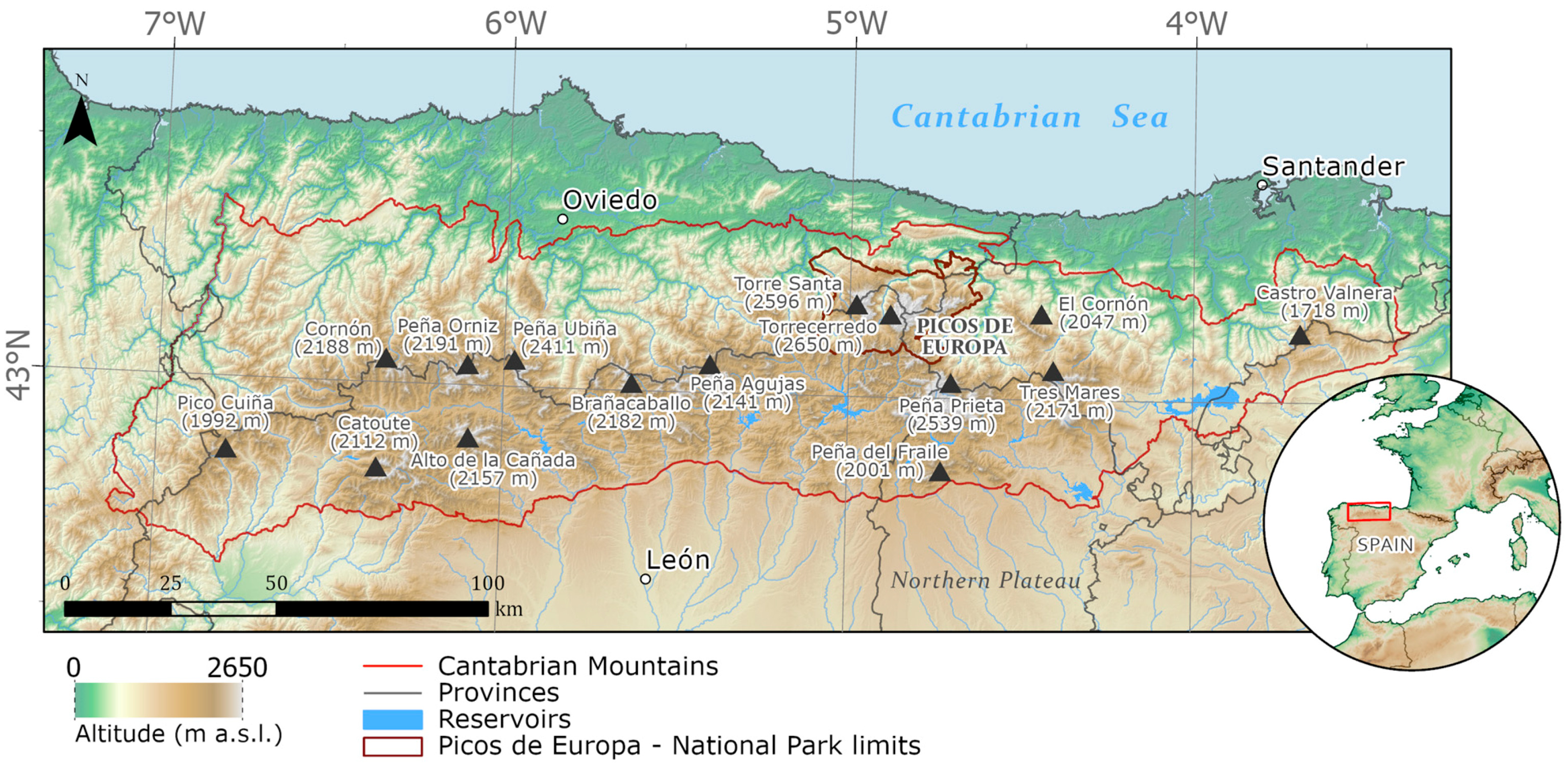

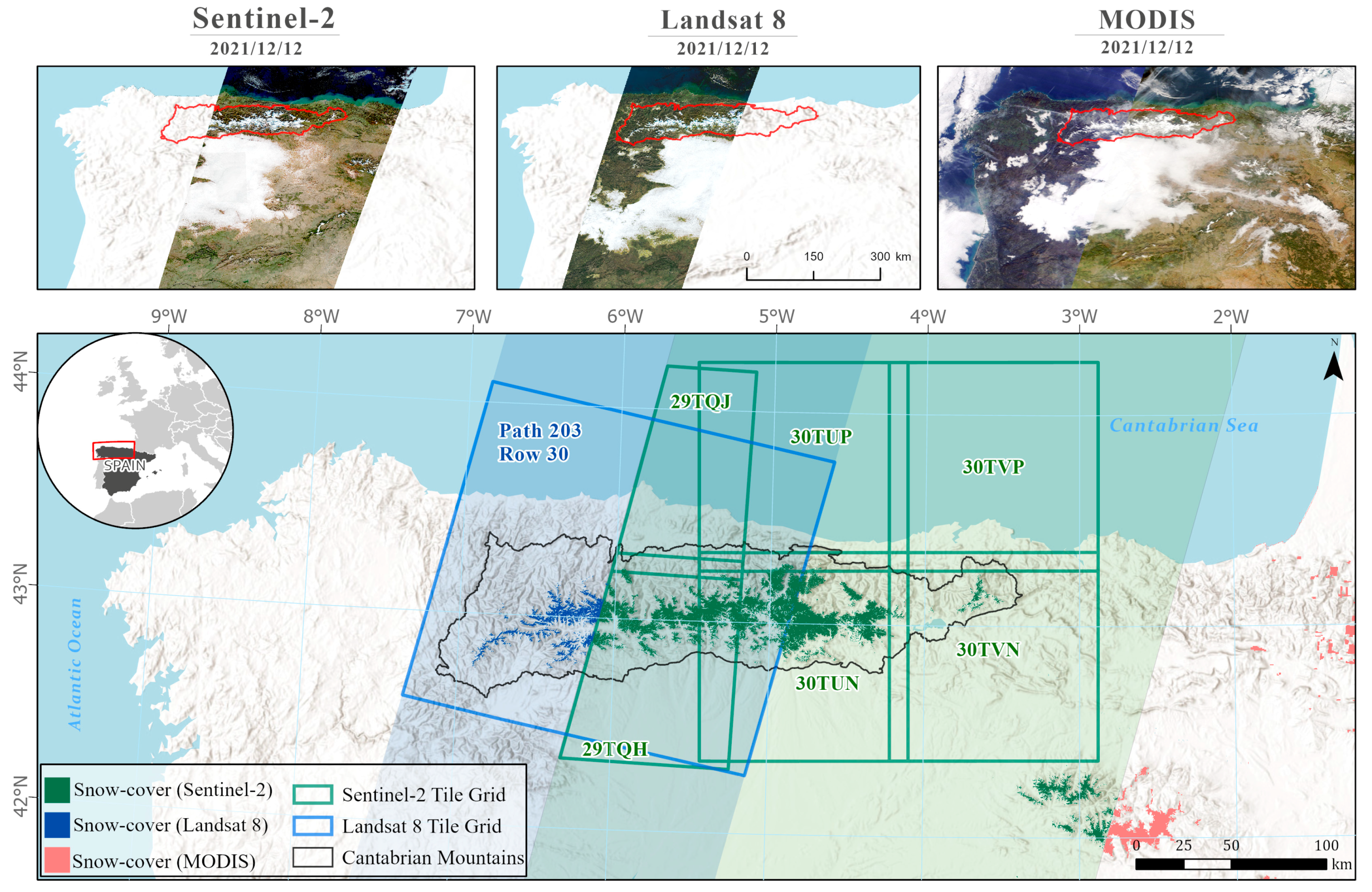
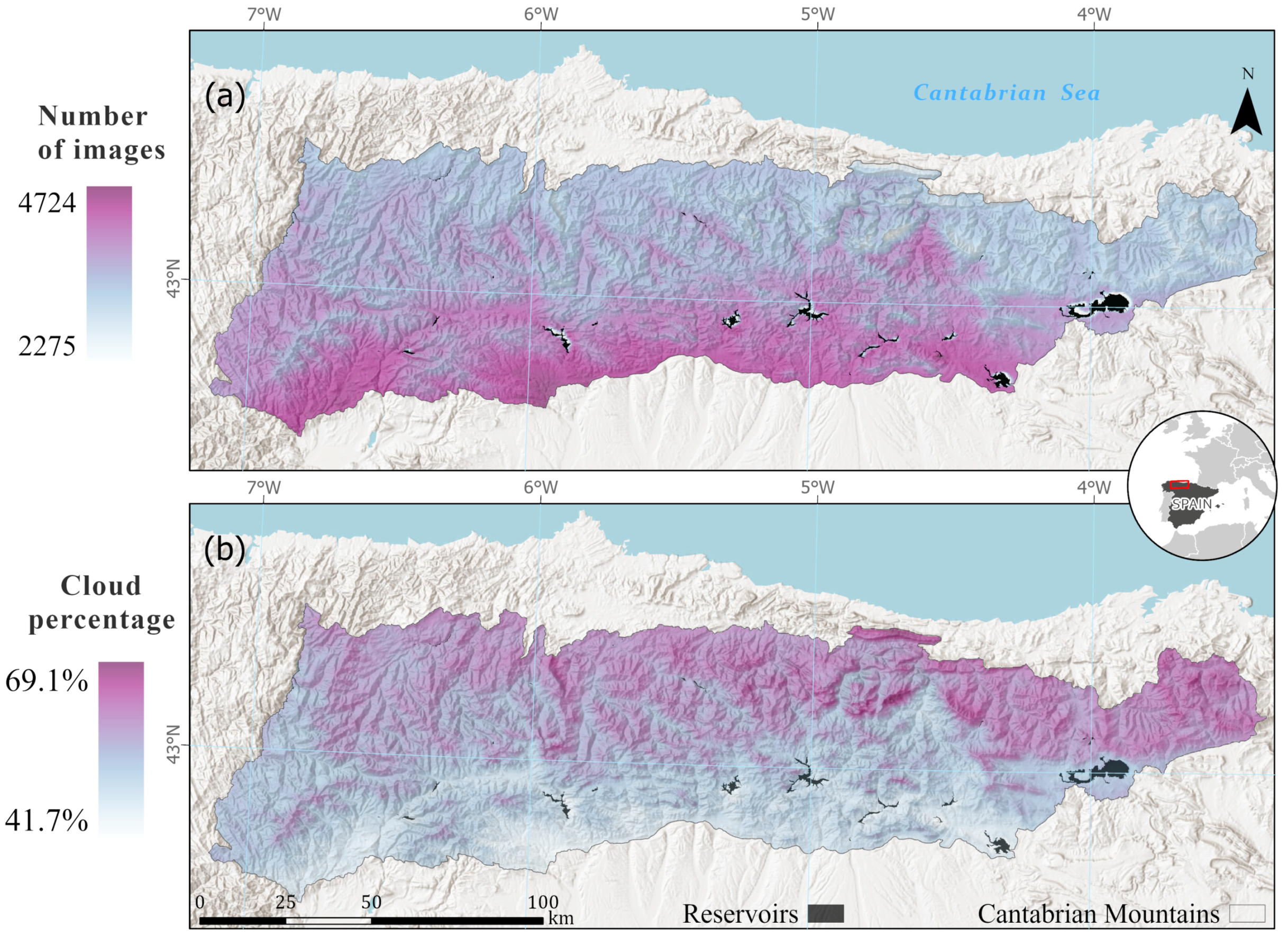
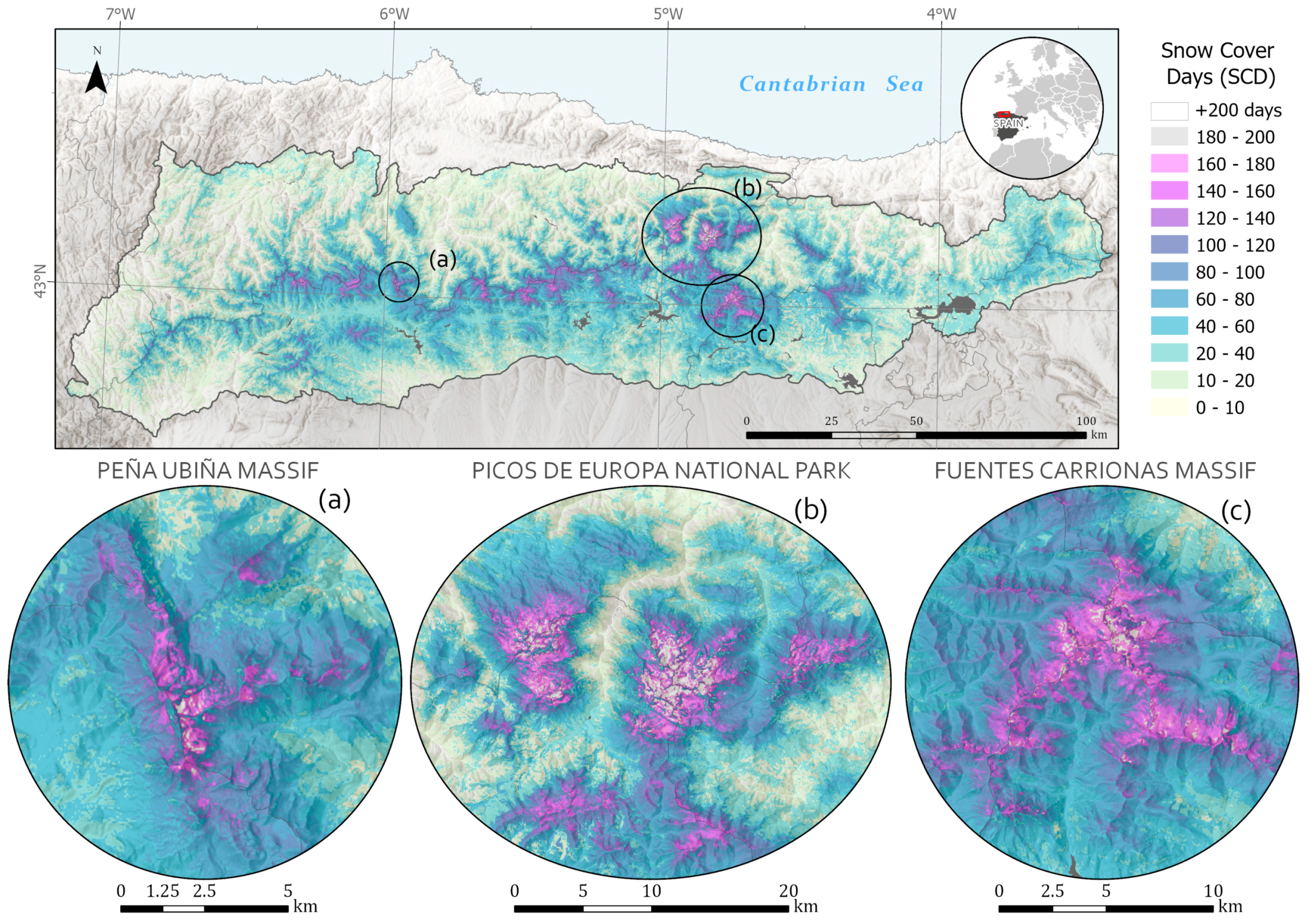

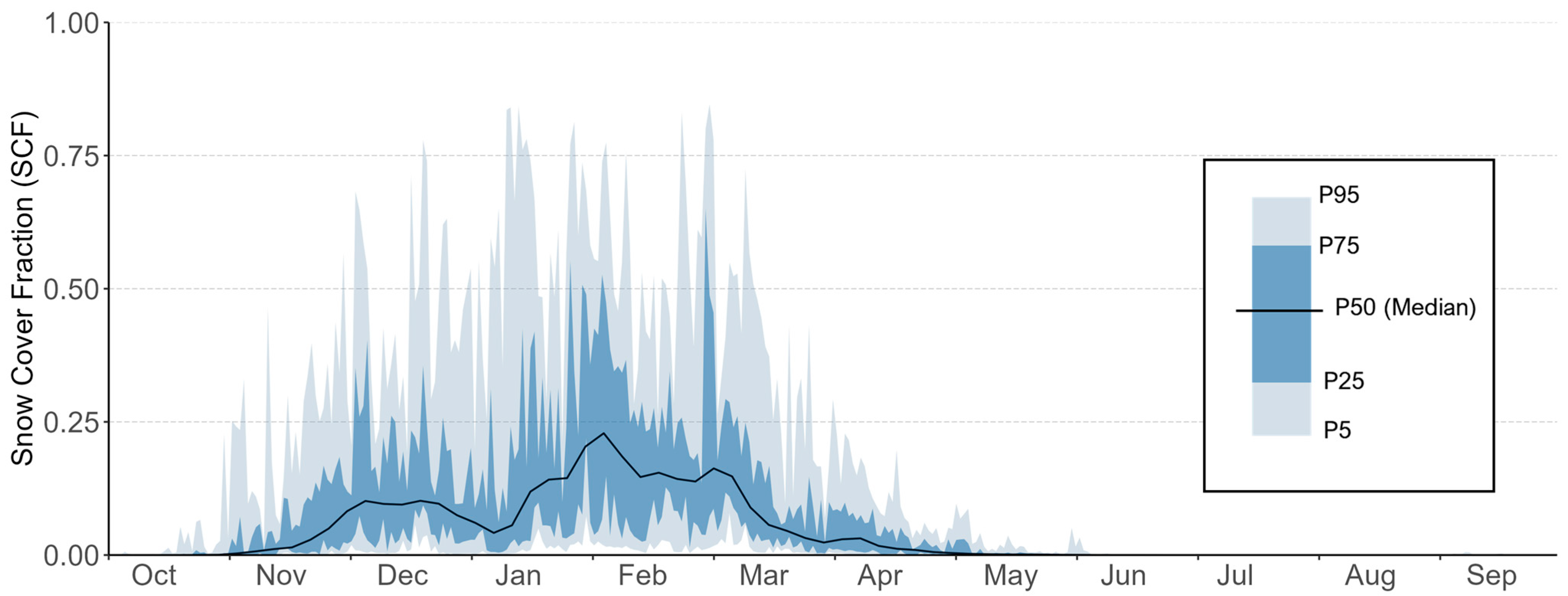
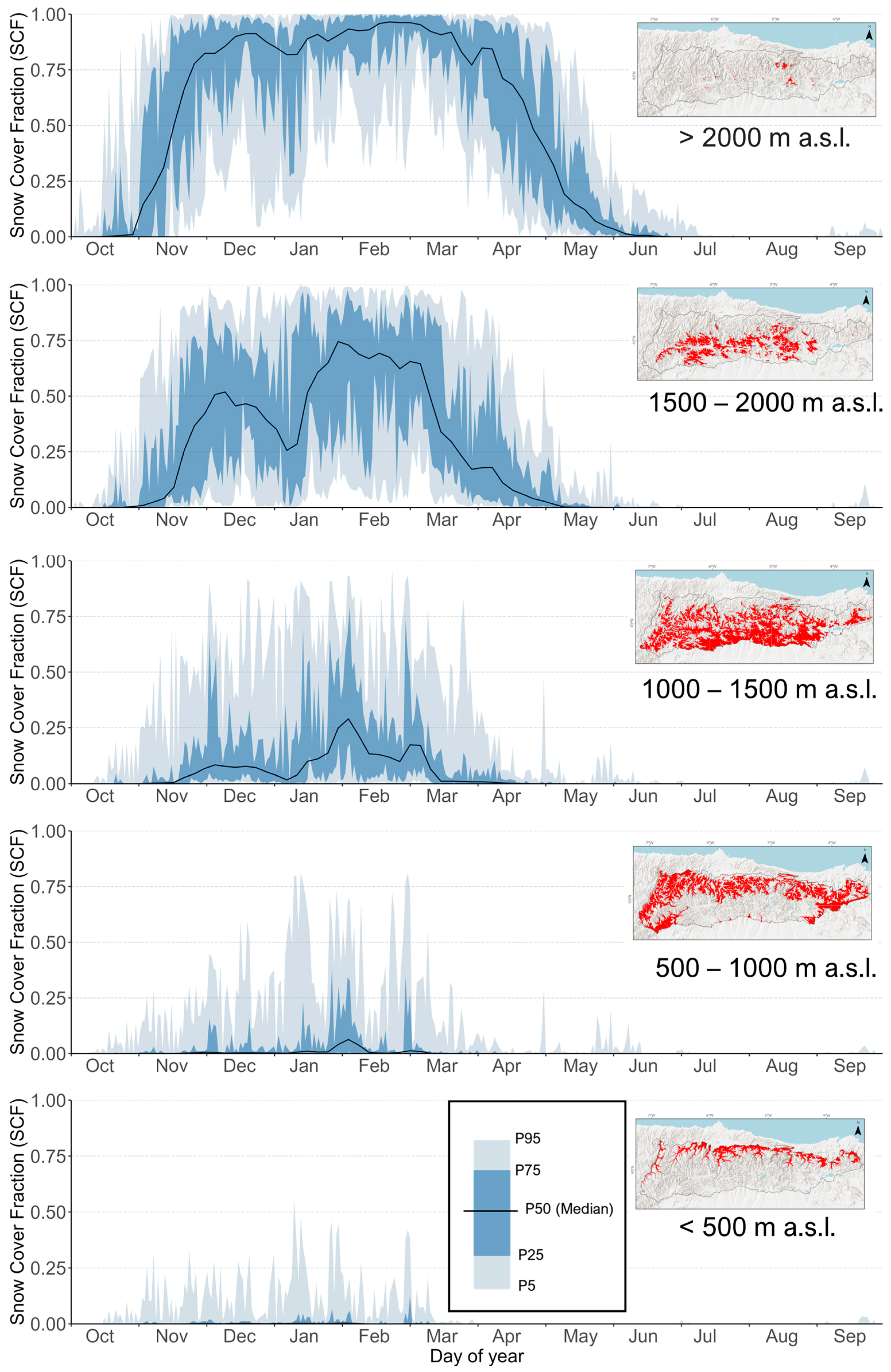
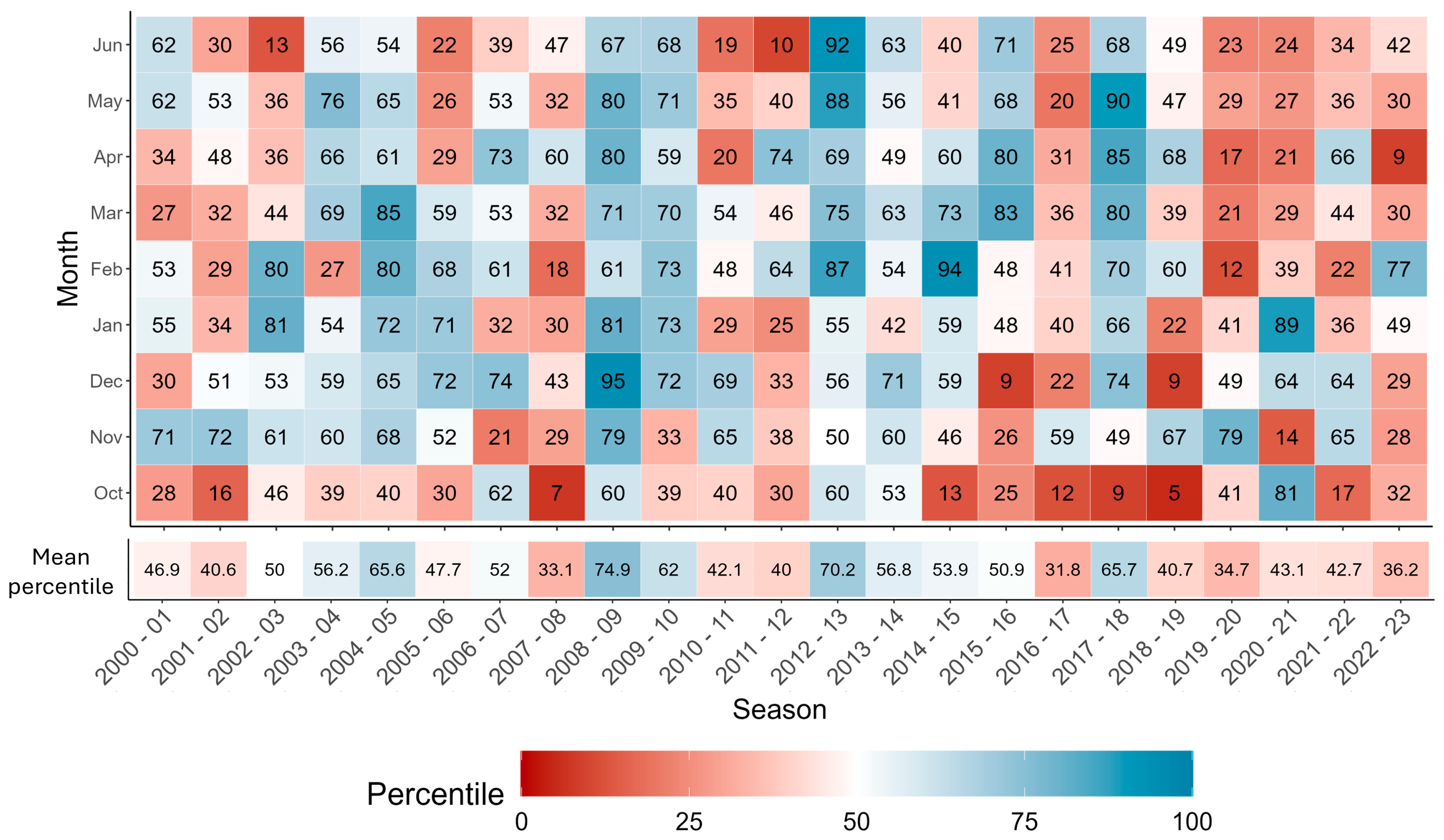

| Google Earth Engine Product | Satellite | Temporal Resolution | Spatial Resolution | Dataset Availability | Number of Images |
|---|---|---|---|---|---|
| Harmonized Sentinel-2 MSI: MultiSpectral Instrument, Level-2A | Sentinel-2A Sentinel-2B | 5 days | 10, 20, 60 m | 2015–present | 4349 |
| USGS Landsat 5 Level 2, Collection 2, Tier 1 | Landsat-5 | 16 days | 30 m (TM bands) | 1984–2012 | 514 |
| USGS Landsat 8 Level 2, Collection 2, Tier 1 | Landsat-8 | 16 days | 15, 30, 100 m | 2013–present | 1101 |
| MOD10A1.061 Terra Snow Cover Daily Global 500 m | Terra-MODIS | Daily | 250, 500, 1000 m | 1999–present | 4867 |
| Satellite | Green Band | Green Band Wavelength | SWIR Band | SWIR Band Wavelength |
|---|---|---|---|---|
| Sentinel-2 | B3 | 560 nm | B11 | 1610 nm |
| Landsat-5 | B2 | 520–600 nm | B5 | 1550–1750 nm |
| Landsat 8 | B3 | 530–590 nm | B6 | 1570–1650 nm |
| MODIS | B4 | 545–565 nm | B6 | 1628–1652 nm |
| Satellite | Snow Covered | Snow Free |
|---|---|---|
| Sentinel | 6 | 5 |
| Landsat | 4 | 3 |
| MODIS | 2 | 1 |
| Mean SCDs (2000–2023) | Standard Deviation SCDs (2000–2023) | SCDs Maximum Mean Pixel (2000–2023) | |
|---|---|---|---|
| Cantabrian Mountains (0–2650 m a.s.l.) | 30.1 | 26.3 | 307.6 |
| >2000 m a.s.l. | 131.6 | 40.9 | 307.6 |
| 1500–2000 m a.s.l. | 69.0 | 29.6 | 231.9 |
| 1000–1500 m a.s.l. | 29.6 | 16.1 | 75.7 |
| 500–1000 m a.s.l. | 15.5 | 7.9 | 39.7 |
| <500 m a.s.l. | 5.7 | 3.6 | 13.1 |
| Absolute Trend (Days/Year) | Absolute Significant Trend Areas (Days/Year) (95% Confidence Level) | Relative Trend (%/Year) | Relative Significant Trend Areas (%/Year) (95% Confidence Level) | |
|---|---|---|---|---|
| Cantabrian Mountains (0–2650 m a.s.l.) | −0.258 | −0.921 | −1.003 | −2.459 |
| >2000 m a.s.l. | −0.581 | −1.395 | −0.582 | −1.470 |
| 1500–2000 m a.s.l. | −0.789 | −1.350 | −1.542 | −2.497 |
| 1000–1500 m a.s.l. | −0.257 | −0.906 | −1.157 | −3.153 |
| 500–1000 m a.s.l. | −0.089 | −0.235 | −0.890 | −2.501 |
| <500 m a.s.l. | −0.002 | −0.015 | −0.056 | −0.353 |
Disclaimer/Publisher’s Note: The statements, opinions and data contained in all publications are solely those of the individual author(s) and contributor(s) and not of MDPI and/or the editor(s). MDPI and/or the editor(s) disclaim responsibility for any injury to people or property resulting from any ideas, methods, instructions or products referred to in the content. |
© 2024 by the author. Licensee MDPI, Basel, Switzerland. This article is an open access article distributed under the terms and conditions of the Creative Commons Attribution (CC BY) license (https://creativecommons.org/licenses/by/4.0/).
Share and Cite
Melón-Nava, A. Recent Patterns and Trends of Snow Cover (2000–2023) in the Cantabrian Mountains (Spain) from Satellite Imagery Using Google Earth Engine. Remote Sens. 2024, 16, 3592. https://doi.org/10.3390/rs16193592
Melón-Nava A. Recent Patterns and Trends of Snow Cover (2000–2023) in the Cantabrian Mountains (Spain) from Satellite Imagery Using Google Earth Engine. Remote Sensing. 2024; 16(19):3592. https://doi.org/10.3390/rs16193592
Chicago/Turabian StyleMelón-Nava, Adrián. 2024. "Recent Patterns and Trends of Snow Cover (2000–2023) in the Cantabrian Mountains (Spain) from Satellite Imagery Using Google Earth Engine" Remote Sensing 16, no. 19: 3592. https://doi.org/10.3390/rs16193592
APA StyleMelón-Nava, A. (2024). Recent Patterns and Trends of Snow Cover (2000–2023) in the Cantabrian Mountains (Spain) from Satellite Imagery Using Google Earth Engine. Remote Sensing, 16(19), 3592. https://doi.org/10.3390/rs16193592





